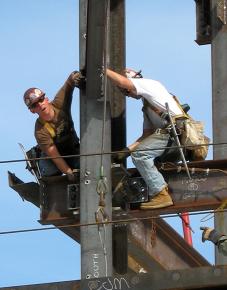Constructing concessions
argues that the conservatism of the leadership of New York's building trades unions extends to their refusal to organize the army of non-union workers that is being used to undercut them.
EVERYWHERE, U.S. labor is divided against itself with government workers pitted against private-sector workers. Even in the Wisconsin recall election, 48 percent of the people in union households voted for the Republican Gov. Scott Walker, whose whole campaign was one long attack on state workers.
Construction unions in New York State have taken this to a whole new level by contributing $500,000 to a committee backing Democratic Gov. Andrew Cuomo's attacks on state and municipal workers.
The Committee to Save New York was set up by business interests, including construction companies, to promote Cuomo's agenda of cutting wages, benefits and pensions for government workers. It is also backing development projects the unions hope will provide jobs for their members.
It would be tempting to just write this off as yet another example of the shortsighted conservatism of the leadership of the building trades unions. The great New York journalist Murray Kempton once observed that the construction unions would support the Nazis building of crematoria if it provided union jobs.
Still the construction unions have their own valid concerns. One labor official, speaking anonymously, told the New York Times that, unlike public workers, union members in the building trades--electricians, construction workers and plumbers--don't get benefits unless they can get private-sector work. "We don't have pension funds if our members are not working," the official said. "We don't have health insurance if our workers are not working."
If union members aren't working, it's largely because more and more New York construction is non-union. According to the Regional Plan Association, non-union construction was 15 percent of the market in the 1970s and is about 40 percent now and growing rapidly.
FOR YEARS, non-union construction was confined to small residential projects in the outer boroughs outside of Manhattan. Now a non-union contractor is building a 37-story hotel on West 42nd Street, in the heart of Mid-Town Manhattan. The same company has a 37-story building under construction at Lexington Avenue and East 45th Street.
Just to the south, on West 30th Street, they are building a 22-story Courtyard by Marriott. The trend is very clear--non-union construction is steadily increasing, and there are fewer union jobs every day.
Union contractors are demanding and getting concessions from the building trades unions, saying that it costs them 20-30 percent more to use union labor. The ironworkers union has agreed to a 15 percent compensation cut--or about $14 an hour less in wages and benefits. The painters went even further, accepting a one-year wage freeze and 1.9 percent raise over four years in Manhattan and a 20 percent cut in payroll costs in the outer boroughs. The union has also agreed to eliminate its hiring hall and reduce their health care costs by 10 percent, or about $4.4 million.
All this could change if the unions would organize the rapidly growing army of unorganized construction workers. But, so far, that's exactly what the leaders of the building trades unions won't do.
They'll have members stand outside a massive non-union job handing out leaflets to the public. They'll even bring out the large inflatable union rat.
None of this gets much sympathy from the non-union workers. They know that instead of trying to organize them, the unions are asking the employers to fire them and replace them with union labor.
In a city where a unionized journeyperson can make as much as $60,000 to $85,000 a year along with family health insurance and pension benefits, according to the Fiscal Policy Institute, it shouldn't be impossible to organize unorganized construction workers. Workers who won a union contract would immediately get a huge increase in wages and benefits together with safer, more tolerable, working conditions and union protection on the job.
The antiquated craft unionism in construction makes organizing difficult by dividing workers up into dozens of different trades. Even this problem wouldn't be insurmountable if the unions were serious about organizing. They could, for example, form an alliance to organize non-union jobs. If even the carpenters, ironworkers, laborers and plumbers joined together, massive organizing could be done in a short space of time.
A serious organizing drive, bringing in thousands of African American, Asian and Latino members, would dramatically increase the unions' political clout. They could have important new allies in communities that now treat them with suspicion, if not outright hostility. That would do more to help win public works projects than all their contributions to Cuomo's pro-business Committee to Save New York.
But it's up to the whole labor movement, not just the construction unions, to campaign for the massive public works projects New York needs and deserves. Any New Yorker who walks around their own neighborhood sees the schools, hospitals and libraries that need to be built and the massive need for affordable housing construction. We badly need new subway lines and tunnels and our bridges will fall down without constant rehabilitation and repair. All this would provide full employment for construction workers for years, if not decades, to come.
So far there's no sign of that kind of united response. Each union tends to go its own way trying, largely unsuccessfully, to protect their own members by currying favor with the Democrats in Albany.
If that doesn't change soon, all working people will pay the price in lower wages, more unemployment and deteriorating living conditions.



